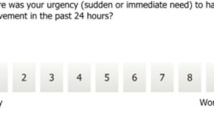Abstract
Adequate measures of diarrheal disease are important to assess severity for clinical use and outcomes research. We developed a questionnaire to assess diarrhea severity and complications, and administered it to 205 HIV positive patients with diarrhea, fever, or weight loss. Noteworthy variations in stool form were reported by individuals and across subjects. Self-reported diarrhea correlated with the occurrence of any stool picture without form. However, verbal descriptors “loose” and “semiformed” had little value in assessment of diarrheal disease. Both verbal and pictorial stool descriptors correlated well with diarrhea complications (pain, urgency, tenesmus, incontinence, and nocturnal diarrhea). By factor analysis, discomfort and nondiscomfort diarrhea complications loaded on different factors, consistent with clinical experience that discomfort is a distinct problem in diarrheal disease. In summary we have developed an instrument to precisely characterize diarrhea severity that correlates well with clinically important events such as incontinence and abdominal pain.
Similar content being viewed by others
References
Guttman LA: Some necessary conditions for common factor analysis. Psychometrica 19:149–155, 1954
Cattell RB: The scree test for the number of factors. Multivariate Behav Res 1:245–250, 1966
Montanelli RD, Humphreys LG: Latent roots of random data correlating matrices with squared multiple correlations on the diagonal: A Monte Carlo study. Psychometrika 41:341–349, 1976
Hendrickson AE, White PO: Promax: A quick method for rotation to oblique simple structure. Br J Stat Psychol 17:65–69, 1964
Hadorn DC, Hays RD, Uebersax J, Haber T: Improving task comprehension in the measurement of health state preferences: A trial of information cartoon figures and a paired-comparison task. J Clin Epidemiol 45:233–243, 1992
Landgraf JM, Nelson EC, Hays RD, Wasson JH, Kirk J: Assessing function: Does it really make a difference? A preliminary evaluation of the acceptability and utility of the COOP function charts;In Functional Status Measurements in Primary Care. M Lipkin (ed). New York; Springer-Verlag, 1990, pp 150–165
Mallett SJ, Lennard-Jones JE, Bingley J, Gilon E: Living with the disease. Colitis. Lancet 2:619–621, 1978
Lubeck DP, Bennett CL, Mazonson PD, Fifer SK, Fries JF: Quality of life and health service use among HIV-infected patients with chronic diarrhea. J AIDS 6:478–484, 1993
Author information
Authors and Affiliations
Additional information
Support for this project was provided by the Agency for Health Care Policy and Research, grant#R01-HS06775.
Rights and permissions
About this article
Cite this article
Mertz, H.R., Beck, C.K., Dixon, W. et al. Validation of a new measure of diarrhea. Digest Dis Sci 40, 1873–1882 (1995). https://doi.org/10.1007/BF02208649
Received:
Accepted:
Issue Date:
DOI: https://doi.org/10.1007/BF02208649



